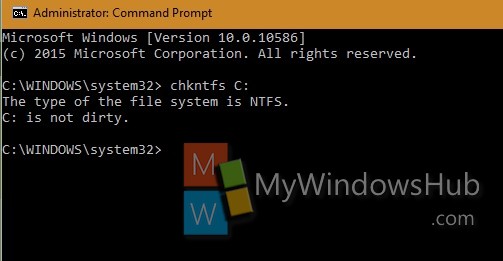
- #How to run a disk check on startup windows 10 windows 10#
- #How to run a disk check on startup windows 10 Pc#
After complete all processes Close Command prompt.

After 100% complete the scanning process again Run the sfc / scannow command. The process is slow and sometimes, you may think that it is stuck, usually at 30-40%. To do this open command prompt as administrator, type the command bellow and hit the enter key.ĭISM /Online /Cleanup-Image /RestoreHealth Now We are going to perform DISM RestoreHealth to scan and repair system images. And RestoreHealth does all of the repair work.
#How to run a disk check on startup windows 10 windows 10#
check health and ScanHealth both check whether your Windows 10 image is damaged. Then we need to run The DISM Tool Which Scan And repairs the System image and allows the SFC utility to do its job.ĭISM Offer Three Different options such as DISM CheckHealth, ScanHealth, and RestoreHealth. If SFC utility Results system file checker found corrupt files but were unable to fix them or windows resource protection found corrupt files but was unable to fix some of them. Wait until 100% complete the scanning process after that Restart the windows and check windows start normally. If found any the utility will restore them from a special folder located on %WinDir%\System32\dllcache. This will start the scanning process for missing or corrupted system files. Now type command sfc /scannow and hit the enter key. To Run this Open Command prompt as administrator, To do this click on start menu search type cmd and press shift + ctrl + enter. Windows have a build-in SFC Utility, which scans and restore missing corrupted system files.
#How to run a disk check on startup windows 10 Pc#
If the repair process results in startup repair couldn’t repair your PC or automatic repair couldn’t repair your PC follow the next step.Īfter performing these commands close the Command prompt and again from Advanced options try to boot into safe mode and perform bellow solutions.

When you select startup repair this will restart the window and start the diagnostic process. Here on Advanced options First use the startup Repair option and let windows to fix the problem itself for you. This will represent you with various Startup troubleshooting tools to fix different startup problems. On the next screen, Select Troubleshoot then click on Advanced options. Press F10 to save this will Restart windows press any key to boot from installation media.įirst Set the language preference, click next, and click on the Repair Computer option. Now move to the boot tab and change the first boot of your installation media ( CD/DVD or Removable Device ). Insert the installation media, Access BIOS setup by press the Del key. To Access Advanced options you need windows installation media, If you don’t have then created one following link.


 0 kommentar(er)
0 kommentar(er)
